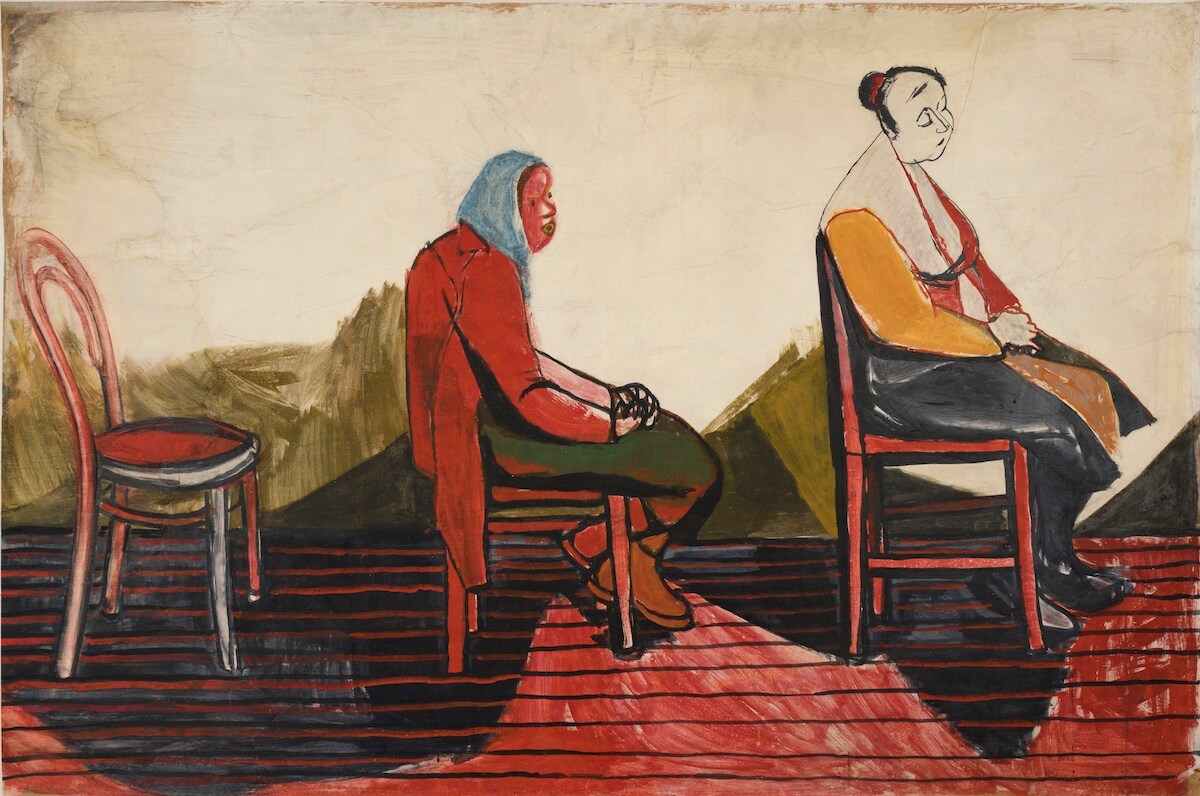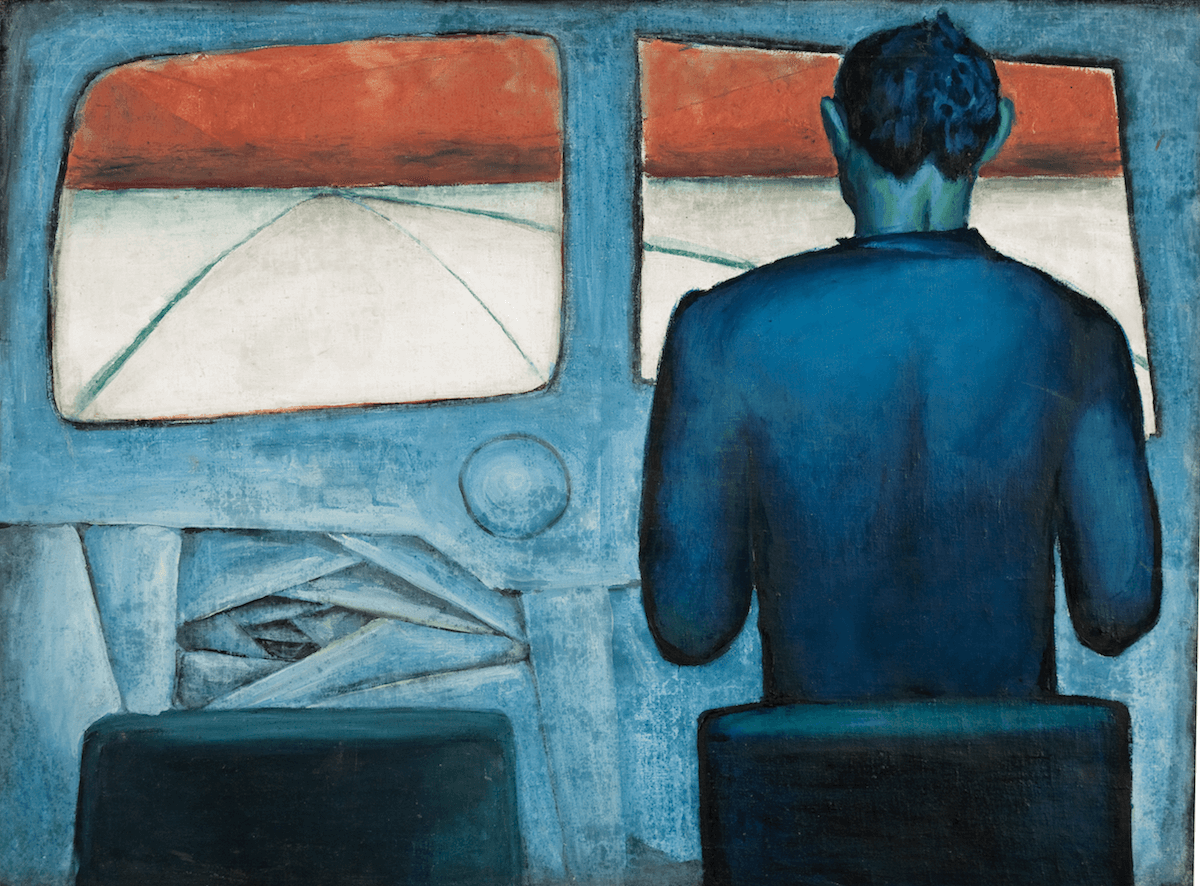Andrzej Wróblewski (1927-1957) In the First Person
Andrzej Wróblewski, Look Out, it Comes! Air Raid; 1955; oil, canvas; 120 × 139.5 cm; Starak Collection; Courtesy © Andrzej Wróblewski Foundation / www.andrzejwroblewski.pl
Ania Muszyńska
The exhibition has been selected as one of the 30 Official Collateral events for the 60th
International Art Exhibition in Venice. Can you tell me about the choice of exhibiting the works of
Polish Painter Andrzej Wróblewski (1927-1957), and the Starak Family Foundation’s history of exhibiting in Venice?
Andrzej Wróblewski is undoubtedly one of the most important Polish painters of the second half of the 20th century. His works are in all national museum collections in Poland. However, Anna and Jerzy Starak are the owners of the largest collection of the artist’s works. This marks our fourth exhibition in Venice. The first was Ryszard Winiarski’s exhibition Event-Information-Image, as an official collateral event of the 57th Biennale Arte in 2017. In the following edition, in 2019, we presented the exhibition Force Field. Emerging Polish Artists, dedicated to young Polish art. During the previous edition in 2022, we presented Ewa Kuryluk’s exhibition I, White Kangaroo, which also received the title of a collateral event. Now, the time has come for a a great classic of Polish painting.
Andrzej Wróblewski lived a very brief life, yet left a profound impact on postwar Polish painting, can you briefly talk us through his artistic career and formation as an artist?
Andrzej Wróblewski represented modern post-war painting, under the emblem of ‘substantial realism’. Realism that opposed the shallow and insignificant mimesis, but became a pretext for expressing the essence of things. Realism whose formula can successfully handle abstract and ambiguous content, and whose new form does not disregard the achievements of the avant-garde. Wróblewski was an artist from Krakow, he operated in an environment centred around two masters of post-war modernity in Poland — Tadeusz Kantor (1915 – 1990) and Mieczysław Porębski (1921 – 2012). As an artist and a young art critic, he made his debut at the First Modern Art Exhibition, opened in December 1948 in the Palace of Art in Krakow, which will go down in the Polish art history as the last such extensive demonstration of post-war, avant-garde art before the coming of the doctrine of socialist realism. On 16 January 1949, Wróblewski began working on the painting Executed Man, Execution with a Gestapo Man. In the following weeks, oils, gouaches on paper and numerous sketches were being created. Until the end of May, he worked tirelessly, creating a series that will become a symbol of a generation. A series which Andrzej Wajda would pay tribute to in his most personal film Everything for Sale from 1968. A series which, to this day, remains the most important testimony of cruelty of the Second World War in Polish art. A series which is known from handbooks and which Poles have imprinted in their consciousness as an illustration of brutal, or even surreal, martyrdom. At the exhibition in Venice, we present several paintings from the “Executions” series. They define the narrative core, which itself is much more multifaceted. I was deeply eager to present a multitude of female portraits by Wróblewski at the exhibition. It is extraordinary how much attention Wróblewski paid to women in his creative work – mothers, wives, girls, modern women. He repeatedly portrayed a characteristic model– showing a matron with a plump and contemplative face, full hips and bust, and worn-out hands, who becomes synonymous with the unconditional care and security that only a mother can give. The above-mentioned model was painted by Wróblewski mainly in the series of Chaired – portraits of aching, resigned women seated on chairs. Halted in this one second of rest from their roles – which, while being difficult and demanding, were not defined by them. At that time their roles were surely underestimated. Wróblewski notices a woman and pays homage to her, makes her the subject and lets her rest. This is a testimony of an extraordinary sensitivity of a young twenty-year-old man in the 1950s, many years before even thinking of any feminist perspective.

Wróblewski’s works are presented on centre stage in St. Mark’s Square, at the Procuratie Vecchie – from a curatorial standpoint, how many works are on show and how do they interact with their surroundings, so steeped in historical significance?
The Procuratie Vecchie is the very heart of Venice. A place from whose windows one can behold St. Mark’s Square and the Basilica. An iconic place for the whole world. We are deeply moved to present Wróblewski’s work here. At the exhibition, we primarily showcase pieces from the collection of Anna and Jerzy Starak. These are complemented by loans from National Museums – there will be paintings from the National Museum in Lublin, Warsaw, and Wrocław, as well as from other private collections. In total, over 70 works will be on display. We also collaborate with the Andrzej Wróblewski Foundation. The exhibition is not a strict monograph. It presents the artist’s most important themes- “Executions”, “Chauffeurs”,”Queues”, “Chaired”, “Tombstones” but I also want to show Wróblewski as a young man of remarkable sensitivity, portraying his contemporaries. However, the main motif remains war. Interestingly, it shall be the second presentation of Andrzej Wróblewski’s work in Venice. The first was the collective exhibition „Mostra di Pittura Polacca Contemporanea” in Sala Napoleonica (now part of Museo Correr) in St. Mark’s Square in 1959 curated by the eminent Polish art historian and curator Ryszard Stanisławski (1921-2000) and the Venetian art historian and critic Guido Perocco (1916-1997).
How does the exhibition respond to Adriano Pedrosa’s main theme for the 60th International Art Exhibition?
Andrzej Wróblewski is an artist who embodies numerous narratives resonating with the core motto of this year’s Biennale, all in one person, and “In the First Person”. Starting from the factual ones – such as being a displaced person, a wanderer, a stranger. He was born in Vilnius, then came the war, repatriations, a new environment, and a complete change of surroundings. Many of his paintings depict people in waiting rooms, at train stations, on the road. But it’s also about all the themes associated with his emotional estrangement. Andrzej Wróblewski as an eternal wanderer and outsider fits perfectly into the theme. Furthermore, his painting is still very intense and vivid. He intensely described the wartime, a time painfully experienced, a time of loss and death. Today, as the war in Ukraine continues, the artist’s paintings depicting its horror speak to us again. Wróblewski proposed language to express pain, loss, and unease.
Can you briefly inform our readers on the work of the Starak Family Foundation, their mission and dedication to the arts?
Anna and Jerzy Starak own one of the largest and most important private postwar art collections in Poland. For over 15 years, as patrons, they have been actively supporting cultural institutions and significant events. For over 10 years, as part of the activities of the Spectra Art Space of the Starak Family Foundation, they have been promoting exhibition programmes at the Foundation’s headquarters in Warsaw, at 6 Bobrowiecka Street.Our flagship project is the series of monographic exhibitions titled “Masters”, where we showcase outstanding figures of Polish post-war art. In the past, these exhibitions have featured artists such as Magdalena Abakanowicz, Alina Szapocznikow, and Teresa Rudowicz, Roman Opałka, Henryk Stażewski, Tadeusz Kantor, Maria Jarema, as well as Andrzej Wróblewski. Simultaneously, we do not forget about young artistic talents. Over 10 years ago, we launched the SOON_ project, executed in a site-specific convention. We have already had over 75 intriguing installments. Our website, www.starakfoundation.org, hosts a complete archive in the form of short videos and photographic documentation. It’s worth seeing how the Polish young artistic scene has evolved over the past decade.



